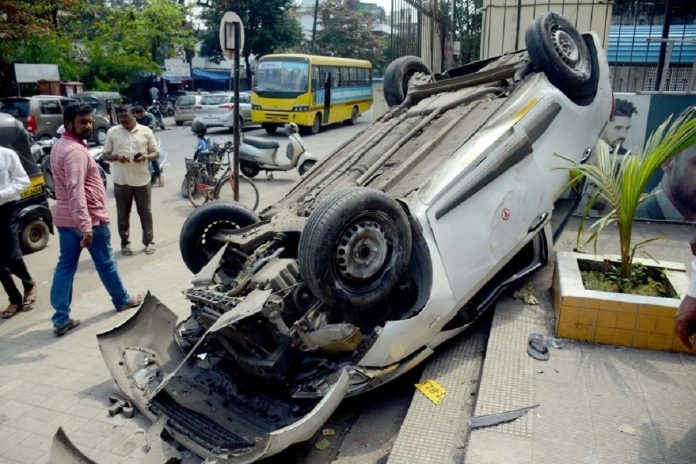Our country which has one of the highest numbers of road crash deaths and injuries in the world, also fares poorly on the compensation awarded to the victims of hit-and-run cases.
A total of 205 claims were filed in the financial year 2022-23, out of which barely 95 claims were settled and a compensation of Rs 1.78 crore in total was paid, according to government data. The claims of the remaining 110 are pending to be cleared.
The alarming statistics which were released as part of the first annual report of the Motor Vehicle Accident Fund Trust, Is a “matter of concern” and leaves a lot to be answered.
In simple words, hit-and-run accidents can be described as a case, where an individual, hits another vehicle while driving and flees away from the spot.
Hit-and-run cases accounted for 13.9 per cent of all accidents and 16.8 per cent of all deaths in 2021, according to road transport ministry data. According to the data, 57,415 hit-and-run accidents occurred in the country in 2021, resulting in 25,938 deaths and 45,355 injuries.
For the year 2020, hit-and-run cases accounted for 14.3 per cent (52,448) of all accidents, killing 23,159 person and injuring 43,789 individuals.
In Delhi alone, 719 people were killed in 708 hit-and-run accidents in 2021, according to the Delhi Road Crash Fatality Report released by the transport department in September 2022.
The high rate of hit-and-run cases indicates non-reporting of accused vehicles, and the apathy of general public and eyewitnesses to report the crashes.
While passers-by witnessing the crash refrain from reporting the matter to police due to legal hassles, lack of surveillance cameras at the crash spot is another important reason for fleeing offenders.
Compensation Scheme
The concept of compensating victims of ‘Hit and Run’ accidents was first introduced in 1982 and administered trough the Solatium Fund Scheme, introduced in 1989.
Such victims were paid a compensation of Rs 25,000 in the event of each death and Rs 12,500 for grievous injuries from the government’s solatium fund.
Considering that the earlier compensation amount was meagre, the government in February this year replaced the Solatium Fund Scheme by the “Compensation to Victims of Hit and Run Motor Accidents Scheme.”
The new scheme has increased the compensation to Rs 2 lakhs for death and Rs 50,000 for serious injuries.
To operationalise this higher compensation, the road transport ministry set up the Motor Vehicle Accident Fund in February 2022 and the fund became operational from 01 April 2022.
According to the report, while a total compensation of Rs 1.74 crore was disbursed to the kin of 87 persons killed in hit and run accidents in FY 2022-23, another Rs 4 lakh was paid to eight persons who were injured.
While the new scheme is a work-in progress, the old scheme suffered from far poor implementation.
According to an official data, the government paid claims in barely 4958 hit-and-run cases — 3,137 for deaths and 1,821 for persons left grievously injured — from FY 2017-18 until March 2022, when the new scheme came into effect.
In a written reply to a question from BJD’s Anubhav Mohanty in Lok Sabha in March 2023, the road transport and highways ministry said that around Rs 10.2 crore claim were paid for the 4,958 cases in the five years.
Poor offtake
The sluggish rate at which claims are being submitted, even with the government’s recent raise in compensation underscores a lack of public awareness regarding the process of applying for compensation.
Even in cases where the claims were submitted, the processing has been delayed on account of issues like old forms submission, discrepancies in submitted documents, and the occasional unclear digital copies, all contributing to payment delays, noted the report.
As such the government has now started taking steps to fix the issues that might be resulting in few victims and their kin applying for the compensation, said the report.
These include an informative website, a dedicated email for effective communication, thorough scrutiny processes, and active engagements with the State Transport Commissioners.
Apart form this, development of a software platform for streamlined processing is also on the anvil to handle claims which are set to increase in the coming years.
Legal Deterrence
While compensating the victims is a necessary step, adequate legal deterrence is also important to prevent such inhumane act.
In a major step towards creating a legal framework, the Bharatiya Nyaya Sanhita (BNS), 2023, brought by the Centre in Parliament, seeking to replace the colonial-era Indian Penal Code (IPC) has proposed a jail term of 10 years if a person is found involved in rash driving, escapes the crime scene and fails to report the incident to police.
Introducing the new provision under section 104 (2), the proposed law says, “Whoever causes death of any person by doing any rash or negligent act not amounting to culpable homicide and escapes from the scene of incident or fails to report the incident to a police officer or magistrate soon after the incident, shall be punished with imprisonment of either description of a term which may extend to ten years, and shall also be liable to fine.”
Currently, incidents of hit-and-run are registered under sections 279 (rash or reckless driving), 304A (causing death by negligence) and 338 (endangering life or personal safety of others) of the IPC. In exceptional cases, 302 (murder) charges are invoked. The punishment for causing death due to rash and negligent driving under 304A is two years.
“Instances of hit and run cases are on the rise and it is necessary to convey that one cannot escape the law,” an official said, explaining the reason for including hit-and-run provisions in the proposed law. “By bringing a law on hit-and-run cases or for that matter mob lynching, a framework has been created which addresses social concerns.”


